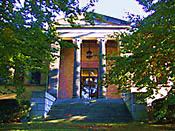E Bruce Brooks
University of Massachusetts at Amherst
The Original Epistle of James
SBL New England, Andover Newton Theological School, 20 Apr 2007
Abstract The Epistle has been dated both early and late, classified as both Jewish and Christian, and said to be both formless and highly structured. So great a disagreement in so many categories suggests that there may be conflicting signs in the text itself. I here examine its integrity, as a first step toward clarifying its historical nature, and find that it contains significant interpolations.
In a text whose connectivity may in fact be low, an interpolation may be difficult to recognize. In particular, a return to a previous topic may be simply a homiletic device of cyclic development. But there are places where the interruptive nature of a segment of the text seems to be more strongly indicated. Thus in James 5:7 we have "Be patient, therefore, brethren, until the coming of the Lord [in judgement]." To what previous sentence dealing with judgement, if only in a catchword way, could this "therefore" refer? Moving back through a denunciation of the rich (5:1-6) and a disapproval of presumption (4:13-17), the first likely possibility seems to be 4:12: "But who are you, that you judge your brother?" The intervening material not only separates these thematically related passages, it differs as a whole from much of the rest of the Epistle, and so supports the hypothesis of interpolation. It differs in several ways:
- it uses "harsh address"
- it does not refer to its audience as "brethren"
- it violates its own canon against judgement by cursing rather than admonishing the rich
- it does so by addressing an imaginary opponent, which evokes the diatribe form
The diatribe form is thought to imply literary sophistication, not mere fluency, in Greek, and this in turn is sometimes thought to be unlikely for one of the early Galilean followers (or relatives) of Jesus. This material is our first proposed interpolation.
Some of these traits, or analogous traits, also occur in four other passages:
- 2:6b-7, making a rhetorical demand of an imagined opponent
- 2:18-26, addressed to "a foolish fellow"
- 3:5b-8, characterizing the tongue as wholly evil, rather than (as in 3:9) ambivalent
- 4:1-10, addressed to "the unfaithful" and "sinners," accusing them of murder
Two further passages are suspect: 2:1b ("as you hold the faith of our Lord Jesus Christ, the Lord of Glory") is interruptive in context, which in turn casts suspicion on the similarly worded 1:1b ("and of the Lord Jesus Christ"). These seven passages together comprise all those which (1) most suggest a Greek diatribe, or (2) are most explicitly Christian, or (3) relate most strongly to a Pauline context. The result of separating the seven from the rest of the text is a two-layer structure, whose original layer has a clearer relation to the Jesus sayings in Matthew and Luke than has so far been made out, and which has reasonable thematic connectivity. The proposed second or interpolated layer, considered by itself, is also intelligible, as a stylistically consistent controversialist intensification of the original, written by someone who was further along the trajectory of emergent Christ-centered Christianity, was better acquainted with specifically Greek rhetoric than the first author, was given to polarized conceptions and extreme statements, and who also had a special animus against the rich. A new suggestion about the identity of the original author of the Epistle, and about the time frame of its second author, can be advanced on this clarified textual basis.
All lectures and abstracts posted on this site are Copyright © by their authors.
2 Feb 2007 / Contact The Project / Exit to Conferences Page
